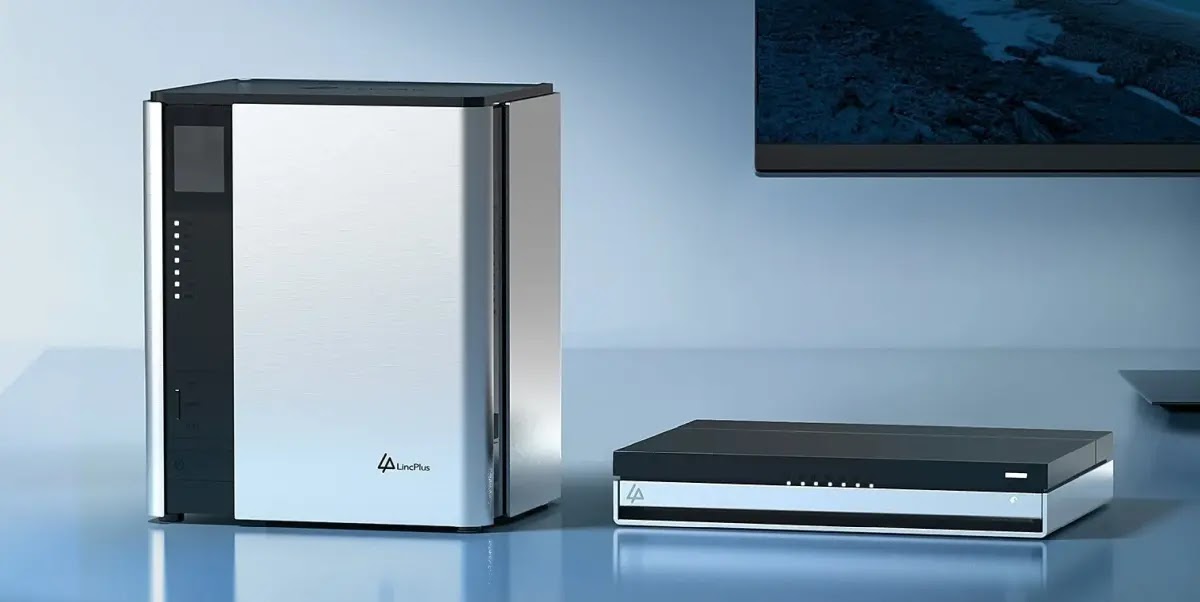An in-depth review of the Link Plus S1 NAS, featuring easy component access, low power consumption, and robust performance with Unraid OS.
Table of Contents
Introduction to the Link Plus S1 NAS
The Link Plus S1 is a new Network Attached Storage (NAS) device that promises to deliver powerful performance in a compact and user-friendly package. This review will explore the key features, setup process, and real-world performance of the Link Plus S1, helping you determine if it’s the right storage solution for your needs.
Hardware Specifications and Design
Storage Capacity and Expansion
The Link Plus S1 offers impressive storage capabilities:
- 4 x 3.5-inch SATA drive bays
- 2 x M.2 NVMe SSD slots
- Maximum raw capacity of 112TB (using 28TB drives)
This configuration allows for a flexible storage setup, combining high-capacity hard drives with fast SSD caching or tiered storage.
Connectivity and Ports
The NAS provides ample connectivity options:
- 2 x 2.5 Gigabit Ethernet ports
- 1 x USB 3.2 Gen 2 Type-C port (10Gbps)
- 1 x USB 3.2 Gen 2 Type-A port (10Gbps)
- 1 x HDMI port
The dual 2.5GbE ports support link aggregation out of the box, potentially offering up to 5Gbps of network throughput.
Processor and Memory
At the heart of the Link Plus S1 is an Intel N97 processor:
- 4 cores
- 3.6 GHz clock speed
- 12W TDP
The NAS comes with 8GB of DDR5 RAM, which is easily upgradeable if needed.
Design and Build Quality
The Link Plus S1 features a thoughtful design that prioritizes ease of use and maintenance:
- Tool-less drive bays for quick and easy drive installation
- Magnetic covers for easy access to internal components
- 1.7-inch LCD screen on the front for system information and management
- Customizable LED lighting
Setup and Installation
Drive Installation
Installing drives in the Link Plus S1 is remarkably simple:
- Remove the magnetic front cover
- Pull out the drive tray
- Insert the 3.5-inch drive into the tray
- Push the tray back in until it clicks
For 2.5-inch SSDs, there are mounting holes in the trays, and screws are provided.
M.2 SSD Installation
Installing M.2 NVMe SSDs is equally straightforward:
- Remove the magnetic top cover
- Locate the M.2 slots
- Insert the SSD at an angle
- Push down and secure with the provided clip
Initial Setup
The Link Plus S1 comes pre-installed with Unraid OS:
- Power on the NAS
- Connect to the web interface using the IP address displayed on the LCD screen
- Follow the Unraid setup wizard to configure your array and shares
Software and Features
Unraid OS
The Link Plus S1 comes with a licensed copy of Unraid OS, offering:
- Flexible storage pooling
- Data protection with parity
- Docker container support
- VM capabilities
- Extensive plugin ecosystem
Docker and VM Support
Setting up Docker containers and VMs is straightforward:
- Docker containers can be deployed with a few clicks
- VMs can be created using downloaded ISO images
- Both Docker and VMs perform well on the Intel N97 processor
Link Aggregation
The NAS supports link aggregation out of the box:
- LACP (802.3ad) mode is available
- Easy to configure in the Unraid network settings
Front Panel Display
The 1.7-inch LCD screen provides quick access to system information:
- Product information
- System status (CPU, memory, temperature)
- Disk status and temperatures
- Network interface details
Also Check: Unify Network 9.1: Key Updates and New Features Explained
Performance
Network Performance
The Link Plus S1 delivers solid network performance:
- Consistent 2.5Gbps speeds in file transfers
- Link aggregation works well, potentially doubling throughput
Storage Performance
Storage performance varies depending on the drives used:
- NVMe SSDs: ~5000 MB/s read speeds (limited by PCIe x2 lanes)
- Mechanical HDDs: ~736 MB/s cached reads
Power Consumption
The Link Plus S1 is remarkably power-efficient:
- Idle: ~42W
- Under load: 50-58W
- Maximum observed: ~58W during stress testing
Noise Levels
The NAS operates quietly:
- No significant increase in ambient noise levels when running
- Brief increase in fan noise during startup, quickly settling down
Pros and Cons
Pros
- Easy drive and component installation
- Low power consumption
- Quiet operation
- Included Unraid OS license
- Versatile with Docker and VM support
- Informative front panel display
- Link aggregation support
Cons
- NVMe SSDs limited to PCIe x2 lanes
- Maximum network speed of 5Gbps (with link aggregation)
Conclusion
The Link Plus S1 NAS is an impressive storage solution that combines ease of use, efficient performance, and versatility. Its tool-less design and easy-access components make it user-friendly for both beginners and experienced users. The included Unraid OS license adds significant value, providing a powerful and flexible software platform.
While the NVMe SSD performance is slightly limited by the PCIe lanes, and network speeds top out at 5Gbps with link aggregation, these limitations are unlikely to be deal-breakers for most users. The low power consumption and quiet operation make it an excellent choice for home or small office environments.
Overall, the Link Plus S1 offers a compelling package at a competitive price point. It’s well-suited for users looking for a capable, expandable NAS solution with the added benefits of Docker and VM support. Whether you’re a media enthusiast, a small business owner, or a tech hobbyist, the Link Plus S1 is definitely worth considering for your storage needs.
Image Credit : Linkplus
